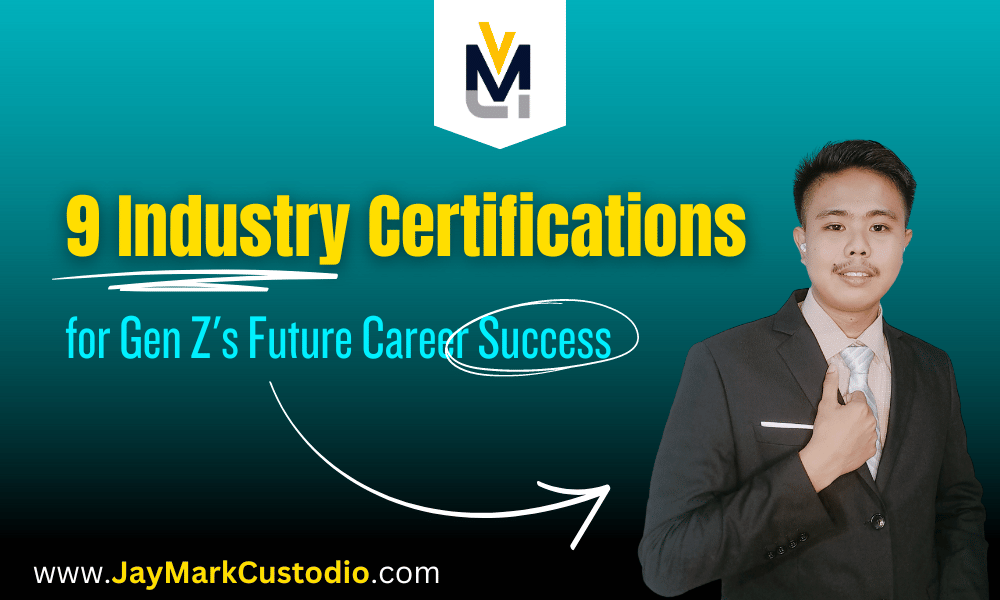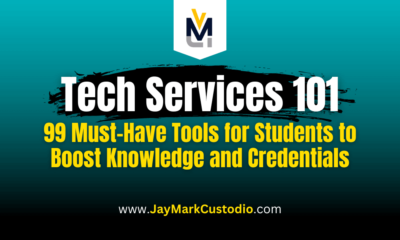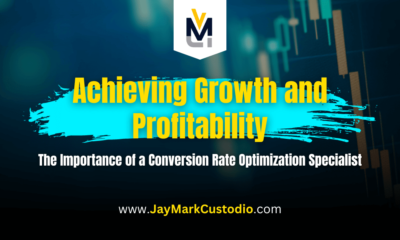In-Demand Skills
9 Industry Certifications for Gen Z’s Future Career Success

Hey there, classmates!
If you’re a Gen Z like me, you’re probably already thinking about your future career and how to make the most of it.
Table of Contents
One way to stand out is by earning industry certifications that show potential employers that you’re serious about your chosen field.
But with so many to choose from, it can take time to figure out where to start.
That’s why I’ve compiled a step-by-step guide to nine industry certifications to help set you up for success.
So, let’s dive in and explore these exciting opportunities together!
Step-by-step guide on how to get certified
1. Research the certifications options available in your field of interest. Look for industry-recognized certifications that will enhance your skills and knowledge and make you more competitive in the job market.
2. Choose the certifications that is best suited for your career goals. Consider the certification requirements, cost, and exam format, as well as the level of difficulty and the value of the certification in your field.
3. Check the eligibility criteria for the certification. Some certifications require specific educational qualifications or work experience, while others may have prerequisites to meet before you can take the exam.
4. Review the study materials and resources for the certification. Many certifications have official study guides, online courses, and practice exams available for purchase.
You can also find free study materials like blogs, forums, and videos on the internet.
5. Attend training programs or boot camps. Some certifications require attending an official training program or boot camp to meet the eligibility criteria.
6. Schedule your certification exam. Once confident in your knowledge and skills, schedule your exam through the certification provider’s website.
7. Prepare for the exam. Make sure you have a solid understanding of the certification exam’s format, content, and time limit.
Practice taking practice exams and review the areas where you need improvement.
8. Take the exam. On the exam day, arrive early and bring your government-issued ID and any other required documents.
Follow the exam instructions carefully and take your time answering the questions.
9. Get your certification and promote it. If you pass the exam, you will receive your certification from the certifications provider.
Add your certification to your resume and LinkedIn profile to showcase your expertise and professional achievement.
You can also network with other certified professionals and attend industry events to stay up-to-date with your field’s latest trends and developments.
Remember, getting certified requires dedication, hard work, and commitment. But, it can be a valuable investment in your future career success and personal growth.
9 Industry Certifications for Gen Z’s
1. AWS Certified Solutions Architect
The AWS Certified Solutions Architect certification validates the skills and knowledge required to design and deploy scalable, highly available, fault-tolerant systems on Amazon Web Services (AWS).
This certification is ideal for professionals working with AWS and designing and implementing solutions using AWS services.
It is considered one of the most valuable cloud certifications in the industry.
Step-by-Step Guide for AWS Certified Solutions Architect
- Determine eligibility – To be eligible for the AWS Certified Solutions Architect certification exam, you must meet the exam prerequisites, including a minimum of one year of hands-on experience designing available, cost-efficient, fault-tolerant, and scalable distributed systems on AWS.
- Choose your certifications level – The AWS Certified Solutions Architect certification exam is available in two levels: Associate and Professional. Choose the level that best aligns with your experience and career goals.
- Create an AWS account – If you still need an AWS account, create one. It will allow you to access the AWS Management Console and practice using AWS services.
- Prepare for the exam – AWS provides various resources to help you prepare for the exam, including official study guides, training courses, practice exams, and sample questions. You can also find third-party study materials and online courses.
- Schedule the exam – Once you feel confident in your knowledge and skills, schedule the exam through the AWS Certification portal. You can take the exam at a testing center or online from home or office.
- Take the exam – On the exam day, arrive at the testing center with a valid photo ID and any other required documentation. If you’re taking the exam online, ensure a reliable internet connection and a quiet, distraction-free environment.
- Receive your results – You will receive your results immediately after completing the exam. If you pass, you will receive an AWS Certified Solutions Architect certification.
- Maintain your certification – AWS certifications are valid for three years. To maintain your certification, you must either pass the current version of the exam or earn a higher-level certifications within that time frame.
2. Google Certified Professional Cloud Architect
This certification demonstrates an individual’s ability to design, develop, and manage secure, scalable, and reliable cloud architecture solutions on the Google Cloud platform.
It is an essential certifications for those seeking a career in cloud computing.
Step-by-Step Guide for Google Certified Professional Cloud Architect
- Understand the Exam: The Google Certified Professional Cloud Architect exam tests your knowledge and skills in designing, developing, and managing secure, scalable, and reliable cloud infrastructure on the Google Cloud Platform (GCP). The exam duration is two hours and costs USD 200.
- Review the Exam Guide: The exam guide provides an overview of the topics covered in the exam. Ensure you understand the exam format, the weightage of each subject, and the recommended study materials.
- Create a Study Plan: Create a study plan that suits your learning style and schedule. Allocate sufficient time for each topic and create a timeline to cover all the issues before the exam date.
- Use Google Cloud Platform: The best way to prepare for the exam is to use the Google Cloud Platform. Create a free account and practice using the services and tools covered in the exam. The more hands-on experience you have, the better prepared you will be.
- Take Online Courses: There are many online courses available that cover the topics in the exam guide. Some recommended courses are Google Cloud Platform Fundamentals, Architecting with Google Compute Engine, and Architecting with Google Kubernetes Engine.
- Join Study Groups: Join online study groups or forums where you can discuss the exam topics with other students and get feedback on your progress.
- Use Practice Tests: Practice tests are an excellent way to assess your knowledge and identify your strengths and weaknesses. Take as many practice tests as you can to prepare for the exam.
- Schedule the Exam: Schedule the exam once you feel confident in your knowledge and skills. Ensure you have sufficient time to prepare for the exam and avoid last-minute cramming.
- Take the Exam: On the day of the exam, ensure you have a reliable internet connection, a quiet place to take the exam, and all the necessary equipment. Read the instructions carefully and answer the questions to your knowledge.
- Celebrate: If you pass the exam, celebrate your achievement! You are now a Google Certified Professional Cloud Architect.
3. Microsoft Certified Azure Solutions Architect Expert
A Microsoft Certified Azure Solutions Architect Expert is a professional who has proven expertise in designing and implementing solutions that run on Microsoft Azure.
They possess advanced computing, storage, networking, and security skills and can translate business requirements into scalable, reliable, and secure cloud-based solutions.
With this certifications, they demonstrate their ability to optimize Azure infrastructure for maximum performance and cost-effectiveness, and guide application design and deployment strategies.
Step-by-Step Guide for Microsoft Certified Azure Solutions Architect Expert
- Choose your exam path: Two exams are required to earn the Microsoft Certified Azure Solutions Architect Expert certification: Exam AZ-303: Microsoft Azure Architect Technologies and Exam AZ-304: Microsoft Azure Architect Design.
- Learn Azure Solutions Architecture: To pass the exams and become certified, you must deeply understand Azure Solutions Architecture. You can learn this by taking an online course, using Microsoft’s official training resources, or reading books on the subject. It would help if you also practiced using the Azure platform to gain hands-on experience.
- Please register for the exams: Once you feel confident about your knowledge of Azure Solutions Architecture, it’s time to register for the exams. You can do this on the Microsoft website by creating an account and scheduling the exams at a testing center near you. Make sure to check the exam fees and any eligibility requirements before registering.
- Prepare for the exams: Use Microsoft’s official study materials and practice exams to prepare for the exams. You can also join study groups or take additional courses for extra help. Review the exam objectives and focus on areas where you need more practice.
- Take the exams: On the exam day, arrive at the testing center early and bring a valid form of identification. The computer-based exams consist of multiple-choice questions, case studies, and scenarios. You will have a set amount of time to complete each exam.
- Get certified: Once you pass both exams, you will receive the Microsoft Certified Azure Solutions Architect Expert certification. This certification is valid for two years, after which you must renew it by taking a renewal exam or earning a qualifying certification.
Congratulations on becoming a certified Azure Solutions Architect Expert!
4. Certified Information Systems Security Professional (CISSP)
This certification is considered the gold standard in the field of information security.
It demonstrates an individual’s knowledge and expertise in designing, implementing, and managing cybersecurity programs.
Step-by-Step Guide for Certified Information Systems Security Professional (CISSP)
- Understand the CISSP certification requirements: It is essential to understand the certification requirements before getting certified. The CISSP certifications requires at least five years of professional experience in information security.
- Check your eligibility: As an international student, you should check if you meet the eligibility criteria for the certification. You should have the necessary work experience and a degree or equivalent qualification in the field of information security.
- Study the CISSP course material: You can prepare for the CISSP exam by studying the course material and resources. The official (ISC)² CISSP training material is available online and can be accessed anywhere.
- Attend CISSP training: You may also choose to attend CISSP training offered by (ISC)² or authorized training partners. You can listen to online or in-person training sessions.
- Schedule and take the CISSP exam: Once you have studied the CISSP course material and completed the training, you can schedule the CISSP exam.
- Pass the CISSP exam: You must score at least 700 out of 1000 on the CISSP exam to pass. You will receive a certificate from (ISC)² if you pass the exam.
- Maintain your CISSP certification: The CISSP certification is valid for three years. You must earn Continuing Professional Education (CPE) credits to maintain your certification. You can earn CPE credits by attending training sessions, conferences, and other educational events.
- Join the (ISC)² community: As a certified CISSP professional, you can join the (ISC)² community and network with other certified professionals worldwide. You can attend online and in-person events and participate in discussion forums.
- Promote your CISSP certification: Finally, you can promote your CISSP certification on your resume, LinkedIn profile, and other professional profiles. It will showcase your expertise and professional achievement to potential employers.
5. Certified ScrumMaster (CSM)
Certified ScrumMaster (CSM) is a certification program offered by Scrum Alliance that validates an individual’s knowledge and understanding of Scrum methodology.
A ScrumMaster is responsible for facilitating the Scrum process and ensuring that the team is adhering to the values, principles, and practices of Scrum.
The CSM certification is recognized globally and is a valuable asset for professionals working in Agile environments.
Step-by-Step Guide for Certified ScrumMaster (CSM)
- Research and Understand the Scrum Framework: The first step towards becoming a Certified ScrumMaster (CSM) is to research and understand the Scrum framework. Many resources available online can help you learn about Scrum, including online courses, videos, blogs, and forums. You can also consider reading the Scrum Guide, the official guide to Scrum.
- Find a Certified Scrum Trainer: The next step is to find a Certified Scrum Trainer (CST) who can provide you with formal training in Scrum. There are many CSTs available around the world that offer in-person and online training courses. You can find a list of CSTs on the Scrum Alliance website.
- Attend a Certified ScrumMaster (CSM) Course: Once you have found a CST, you can attend a Certified ScrumMaster (CSM) course. This two-day training program covers the Scrum framework, roles, events, and artifacts. During the course, you will learn about the principles of Scrum and how to apply them in real-world situations.
- Complete the CSM Exam: After completing the course, you must pass an online exam to become a Certified ScrumMaster. The exam consists of 35 multiple-choice questions; you will have 60 minutes to complete it. You will need to score at least 24 out of 35 questions correctly to pass the exam.
- Join the Scrum Alliance: Once you have passed the CSM exam, you can join the Scrum Alliance as a member. The Scrum Alliance is a global nonprofit organization that supports the Scrum community. As a member, you will have access to a wide range of resources, including networking opportunities, online courses, and community events.
- Maintain Your Certification: To maintain your CSM certification, you must earn Scrum Education Units (SEUs) and renew your certification every two years. You can earn SEUs by attending training courses, webinars, volunteering, and Scrum Alliance events.
That’s it! These six steps will help you become a Certified ScrumMaster and gain the knowledge and skills needed to succeed in a Scrum team.
Good luck with your certifications journey!
6. Project Management Professional (PMP)
Project Management Professional (PMP) is a globally recognized certification for professionals in project management.
It indicates that the individual has extensive knowledge and experience in project management and the ability to lead and direct projects effectively.
Employers across various industries highly value the certifications awarded to the Project Management Institute (PMI).
Step-by-Step Guide for Project Management Professional (PMP)
- Research the PMP Certifications: Before you start your PMP journey, it’s essential to understand what the certification is, what it entails, and what the requirements are. You can visit the Project Management Institute (PMI) website to learn more.
- Meet the Eligibility Criteria: To be eligible to take the PMP exam, you must meet specific requirements, such as education and project management experience. Make sure you review the eligibility criteria carefully to ensure you qualify.
- Join PMI: You must be a member of PMI to apply for the PMP certifications and take the exam. You may be eligible for a discounted membership fee as an international student. Joining PMI also gives you access to study materials and other resources.
- Apply for the Exam: Once you meet the eligibility criteria and become a PMI member, you can apply for the PMP exam. You must provide details of your education and project management experience, contact information, and payment.
- Prepare for the Exam: Preparing for the PMP exam is an essential step in the process. You can use PMI’s study materials, online courses, and practice exams to help you prepare. Consider joining study groups or hiring a tutor to help you prepare.
- Schedule the Exam: Once you feel confident in your preparation, you can schedule your PMP exam. You can take the exam at a Prometric testing center or through PMI’s Online Proctored Exam option.
- Take the Exam: On the day of your exam, arrive early and bring all required identification. The PMP exam consists of 200 multiple-choice questions that you must complete within four hours.
- Receive Your Results: You’ll receive your exam results immediately after you complete the exam. If you pass, you’ll receive your PMP certifications. If you don’t pass, you can retake the exam up to three times within a year.
- Maintain Your Certifications: You must earn 60 professional development units (PDUs) every three years to maintain your PMP certifications. You can earn PDUs by attending seminars, workshops, or other project management-related activities.
7. Certified Financial Planner (CFP)
This certification is considered the gold standard in the financial planning industry.
It demonstrates an individual’s knowledge and expertise in financial planning, investment management, retirement planning, estate planning, tax planning, and insurance planning.
Step-by-Step Guide to CFP Certification
- Determine your eligibility: Before you start becoming a Certified Financial Planner (CFP), you need to determine if you are eligible. You must have a bachelor’s degree or higher from an accredited college or university to be eligible. In addition, you must have completed a CFP Board-Registered program or have equivalent coursework that meets the CFP Board’s education requirement.
- Complete the education coursework: Once you have determined your eligibility, the next step is to complete the education coursework. You can achieve this coursework by enrolling in a CFP Board-Registered program or through independent study. The coursework covers various financial planning topics, including investments, retirement, tax, and estate planning.
- Pass the CFP exam: After completing the education coursework, you must pass the CFP exam. The exam covers the same topics as the coursework and tests your knowledge of financial planning. The exam consists of 170 multiple-choice questions and takes about 6 hours to complete.
- Gain work experience: To become a CFP, you must have at least three years of full-time work experience in financial planning. One can gain this experience by working for a financial planning firm or becoming an independent financial advisor.
- Apply for certification: Once you have completed the education coursework, passed the CFP exam, and gained the required work experience, you can apply for accreditation. The application process includes submitting information on your education and work experience and agreeing to abide by the CFP Board’s Code of Ethics and Standards of Conduct.
- Maintain certification: To maintain your CFP certification, complete 30 hours of continuing education every two years. This continuing education helps you stay up-to-date on financial planning trends and regulations.
8. Professional in Human Resources (PHR) Certification
This certification is for individuals who want to specialize in human resources management.
It covers topics such as recruitment, employee relations, and benefits administration.
Step-by-Step Guide to PHR Certification
- Determine eligibility: To be eligible for the PHR certification, you must have a combination of education and professional HR experience. It would help if you had a high school diploma or equivalent and worked in an HR position for at least two years with a bachelor’s degree or higher or four years with a high school diploma or equivalent.
- Prepare for the exam: Once you’ve determined your eligibility, you must prepare. There are several ways to organize, including self-study, online courses, and in-person classes. You can find study materials and courses on the HR Certification Institute (HRCI) website.
- Please register for the exam. After you’ve prepared for it, you can note it on the HRCI website. You must create an account, pay the exam fee, and select a test center location.
- Schedule the exam: Once registered, you must schedule it at a Pearson VUE testing center. You can design the exam online or by phone.
- Take the exam: On the exam day, arrive at the testing center early and bring a valid, government-issued ID. The exam is computer-based and consists of 175 multiple-choice questions. You’ll have three hours to complete the exam.
- Receive your results: After you’ve completed the exam, you’ll receive your results immediately. If you pass, you’ll receive a certificate and a digital badge that you can use to promote your certification on social media and other platforms.
- Maintain your certification: Once you’ve received your PHR certification, you must maintain it by earning continuing education credits. You must earn 60 credits every three years to maintain your certification.
Remember, the PHR certification is valuable for HR professionals and can help you advance your career. With dedication and hard work, you can pass the exam and earn your certification, even as an international student.
9. Certified Ethical Hacker (CEH)
Certified Ethical Hacker (CEH) is a professional certification course that trains individuals to identify vulnerabilities and weaknesses in computer systems and networks.
The course covers various hacking techniques, tools, and methodologies hackers use to exploit vulnerabilities.
CEH aims to train individuals to think like hackers and use their knowledge to secure computer systems and networks from malicious attacks.
Step-by-Step Guide for International Students to Become a Certified Ethical Hacker (CEH):
- Research the certification: Before beginning your journey to becoming a Certified Ethical Hacker, it’s essential to research the accreditation and understand what it entails. The International Council of E-Commerce Consultants (EC-Council) provides the CEH certification, which is globally recognized.
- Check the eligibility criteria: The next step is to determine eligibility for the certification. The eligibility criteria include having at least two years of professional experience in information security.
- Enroll in a CEH training program: Once you have checked the eligibility criteria, you can enroll in a CEH training program. Several training programs are available online and offline, so you can choose the one that suits your needs and schedule.
- Study for the exam: The CEH exam covers many topics, including network scanning, system hacking, and web application penetration testing. You must thoroughly study the course material to prepare for the exam.
- Take the CEH exam: Once you feel confident in your knowledge of the course material, you can take the CEH exam. The exam is a four-hour multiple-choice exam proctored by an EC-Council representative.
- Get certified: If you pass the CEH exam, you will receive certification from the EC-Council. This certification is valid for three years, after which you must renew it by completing continuing education credits or retaking the exam.
Becoming a Certified Ethical Hacker requires a lot of hard work and dedication, but it can be a rewarding career path for those interested in information security.
Conclusion
That’s it, my classmates!
By now, you should understand the nine industry certifications that can help set you up for success in your future career.
Remember, earning these certifications takes time and effort, but it’s well worth it if you want to stand out to potential employers and achieve your career goals.
So take the first step and choose a certification that aligns with your interests and career aspirations. Then, follow our step-by-step guide to make the process as smooth as possible.
I wish you all the best of luck in your future endeavors!
References
- The Importance of a Certificate in Finance. https://www.idlix.org/2023/06/the-importance-of-certificate-in-finance.html
- March 2023 – Get To Know. https://nerampo.com/2023/03/
- CheckPoint 156-541 Dumps | Updated 2024-02-13. https://www.certification-questions.com/checkpoint-exam/156-541-dumps.html
- How to Earn the Nutanix Multicloud Infrastructure Certification?. https://www.globalknowledge.com/us-en/resources/resource-library/white-papers/how-to-earn-the-nutanix-multicloud-infrastructure-certification/
- Cloud Computing – Pacific Center for Advanced Technology Training. https://pcatt.org/cloud-computing/
- HPE2-CP05 Exam Questions and Answers (HPE2-CP05 PDF). https://myitguides.com/exams/hp/hpe2-cp05-questions
- Amazon Remote Jobs: How to Find. https://www.freelancingnetwork.org/amazon-remote-jobs-how-to-find/
- Cisco CCNA FAQ – Simulation Exams Blog – IT Certification. https://www.simulationexams.com/Blog/ccna-faq/
- CCNA Training South Laurel, MD – Computer Training Maryland. https://computertraining-maryland.com/ccna/ccna-training-south-laurel-md/
- 700-105 Questions Answers – Learn to Pass 700-105 Exam. https://www.certswarrior.com/exam/700-105/
- Chandran, Archana, and Bindu Nair. “Family Climate As a Predictor of Emotional Intelligence in Adolescents.” Journal of the Indian Academy of Applied Psychology, vol. 41, no. 1, 2015, pp. 167-173.
- Free SAP P_SECAUTH_21 Exam Questions and Answers – Certsgrade. https://www.certsgrade.com/pdf/p_secauth_21/
- Canada Express Entry – 7,000 Candidates With Lower CRS got ITAs for Canada PR – Canadian Dream. https://gocanadiandream.com/7000-candidates-invited-to-apply-for-canada-pr-express-entry-draw/
- How to Network With Other Entrepreneurs: 7 Tips for Success | CO- by US Chamber of Commerce. https://www.uschamber.com/co/grow/thrive/tips-for-networking-with-other-entrepreneurs
- Top 10 Project Management Specialist Certifications. https://resumecat.com/blog/project-management-specialist-certifications
- Agile Flashcards for Frontend Web Developers: Essential Topics for Agile Methodologies in Web Development. https://pixelrocket.store/web-developer-flashcards/frontend-development-flashcards/agile-flashcards-for-frontend-web-developers
- Find Out the Best Marketplace Where Buy and Sale Newly Tokens? – Technic Launcher. https://techniclauncher.org/how-to-find-out-the-best-marketplace/
- Top 10 IT Project Manager Certifications | ResumeCat. https://resumecat.com/blog/it-project-manager-certifications
- Eduardo J. Corretjer-Reyes – Divorce Central: Your Hub for Guidance and Support During Life Changes. https://divorcentral.com/eduardo-j-corretjer-reyes/
- Nominations for Dar Al-Hijrah Board Now Live – Falls Church News-Press Online. https://www.fcnp.com/2020/07/14/nominations-for-dar-al-hijrah-board-now-live/
- Master Your Career with HubSpot Certification: Empower, Excel, and Elevate – ROI Amplified. https://roiamplified.com/insights/hubspot-certification/





















